The signs so far may be more subtle here in Central NY — such as this blueberry starting to leaf out far sooner than it should or glade mallow covered in snow in May — but we see many changes.
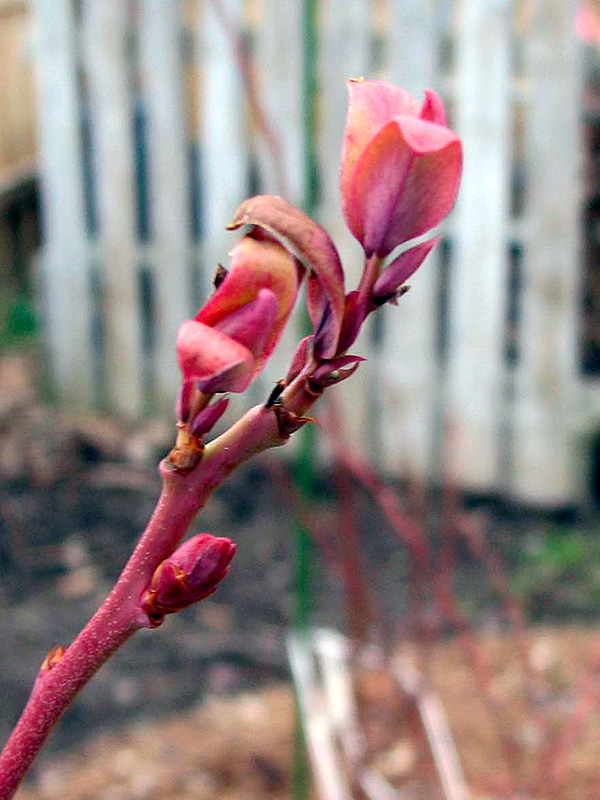
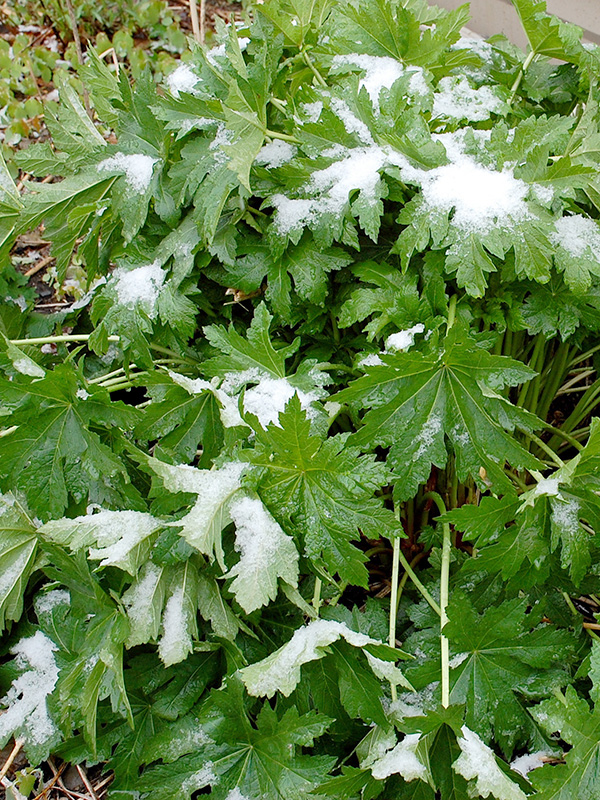
And everybody has noticed an increase in unusual weather. Catastrophic weather events are becoming routine. More ominously, we’ve been seeing 90-degree days in spring — not remotely normal here in CNY!
Just as bad, the last few years have been much drier here. Now (since 2022) I’ve even had to water my planting beds at times — something I never had to do in the past.
Beware of SBS!
Will we keep noticing how different current weather is from the past? Beware the Shifting Baseline Syndrome! I’ve read that it takes only a few years of warmer weather before people start thinking these new conditions are normal. They aren’t! We can’t continue this way! (And, of course, children growing up in these conditions will understandably think this is “normal” since it indeed has been in their lifetime.)
In fact, every ten years NOAA updates the 30-year reference period for what is “normal.” So since 2020, “normal” are temps between 1990 and 2020. What is reported as “normal” now is different from “normal” temps when I was a child (in the 1950s). So these new rapidly-changing “normals” aren’t really normal.
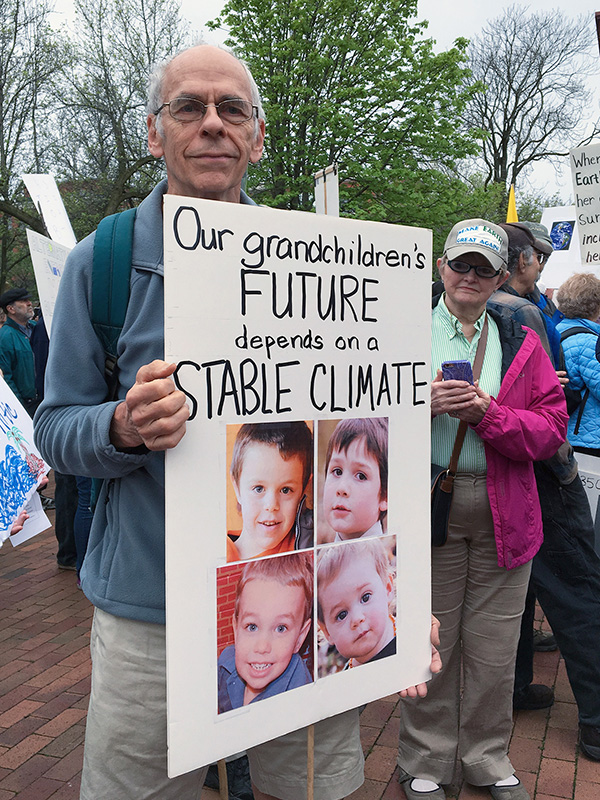
Regardless of the signs of change we may notice, though, we (both science majors) have been convinced for many years that the evidence for the dangers of continued global warming is overwhelming and credible.
It’s very distressing to see that it has become cast as a political issue rather than as the environmental issue it is — especially when our children’s and our grandchildren’s future is at stake, as is the future of everyone’s children.
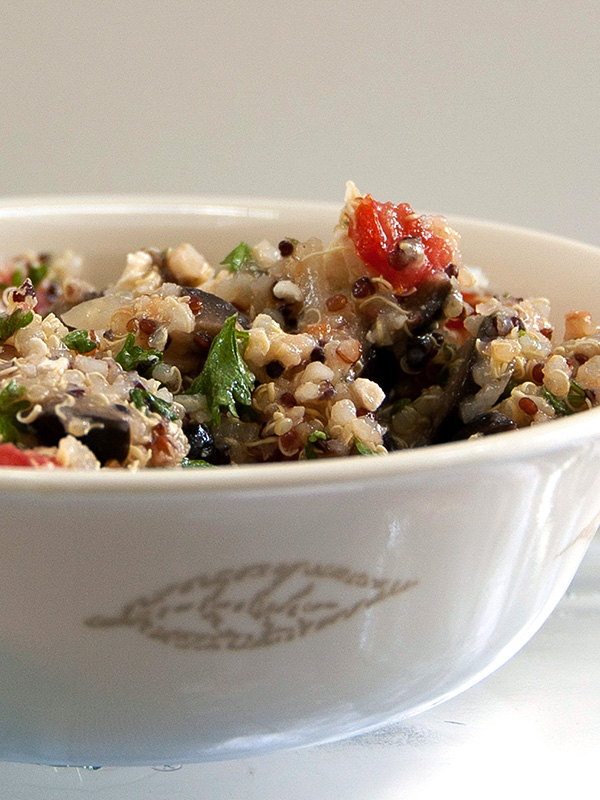
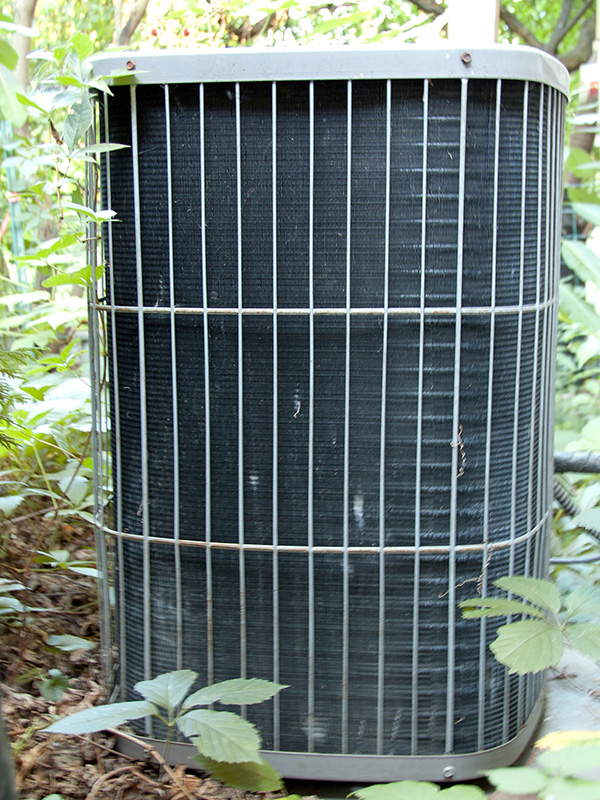
We’re careful about our energy use. Besides using only LEDs throughout the house, we eat a pesca-vegetarian diet (a meat-based diet has a huge climate and water impact!), and we use A/C only on the hottest parts of the hottest days.
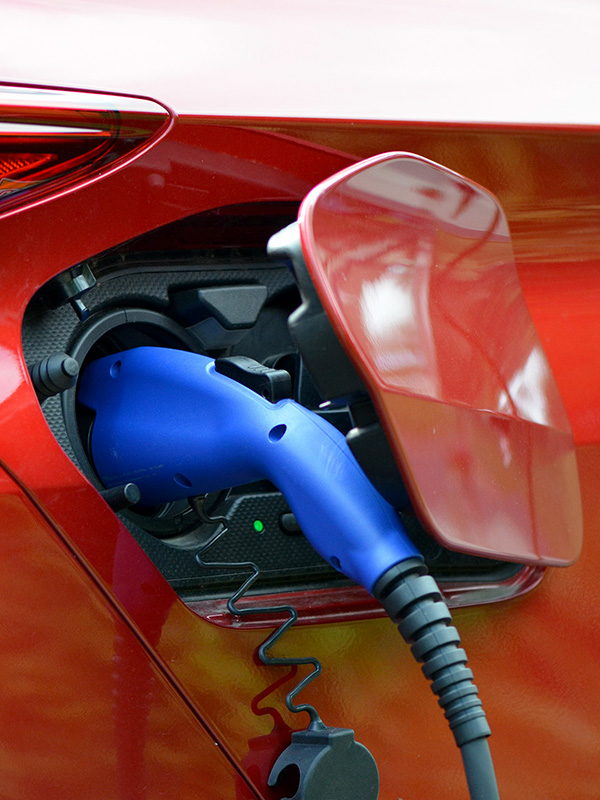
We also drive a 2018 Prius Prime, a plug-in hybrid. With its range of about 30-35 miles, we use gas very infrequently since that’s farther than we generally drive each day. So generally, it’s functioning as an electric car (though burdened by having two engines…).
We expect our next car will be totally electric as the range and number of charging stations increase. This probably won’t happen soon, though, since we don’t put many miles on our car – about 7,000 a year, and we’re extremely happy with this car (which is our only car).
And although we don’t have solar on our house, we subscribe to community solar, so we’re mostly driving on the equivalent of solar energy.
We’re trying to reduce our carbon footprint in many ways — and that includes our yard.
Taking climate action in our landscape and gardens
Most of the things we do in our household relate to energy use — reducing energy and using renewable energy. But there’s increasing recognition that nature-based solutions are also essential and may be even more effective than energy-based solutions. These solutions also help protect biodiversity. And after all, what good is a dead planet with a stable climate?
Although these solutions need to happen on a global level, our yards collectively can be an important part of the solution both for climate and for biodiversity. As Homegrown National Park points out, collectively we cover an area larger than all our national parks put together!
Here are some things we’re doing specifically in our yard:
- Minimizing carbon-emitting inputs
- Not leaving soil naked
- Planting trees and shrubs
- Expanding recycling to the garden
- Thinking long and hard about lawn
- Growing some of our own food
- Some other yard-related actions:
- Solar clothes dryer
- Outdoor lighting
- Community science!
Minimizing carbon-emitting inputs
Power tools used in landscaping are an obvious way to reduce climate pollutants. After reducing the size of our lawn, we found that it only took seven minutes to mow the lawn, thus using a lot less fuel and producing a lot less pollution.
For a while, we tried using a reel-lawnmower, but we found that it just didn’t work well for our lawn.
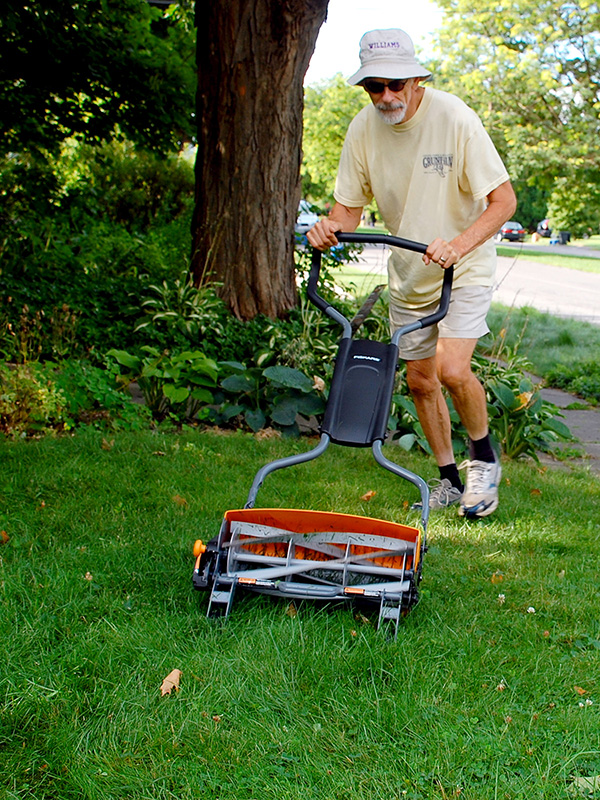
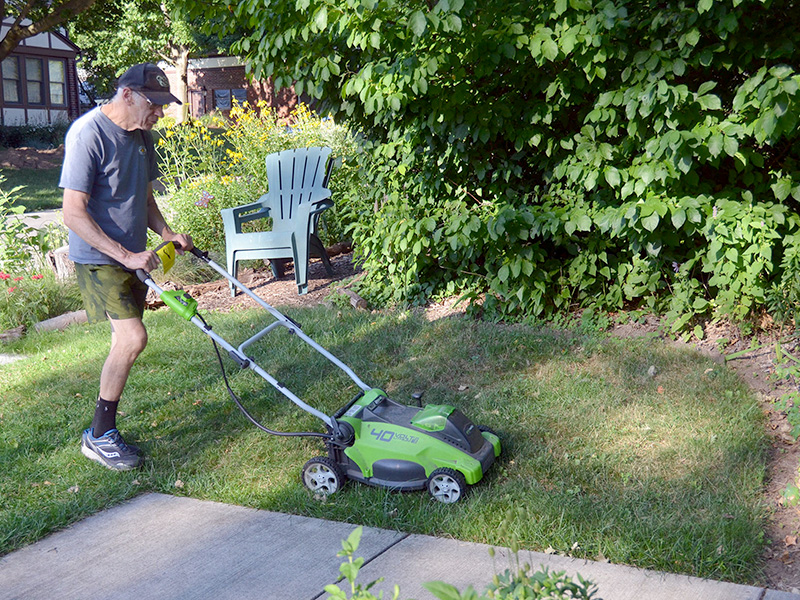
We switched to a rechargeable electric mower, which works very well and doesn’t pollute as much as gas lawnmowers.
But the most important thing is that we have very little lawn to mow, so it takes very little electricity (and very little time).
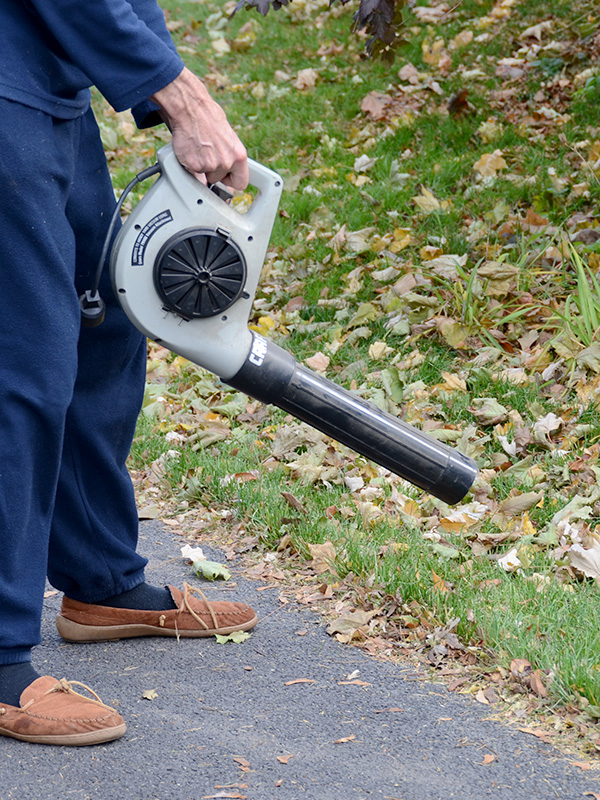
And we don’t need any weed-whackers and certainly not those horrendous noisy and polluting leaf-blowers!
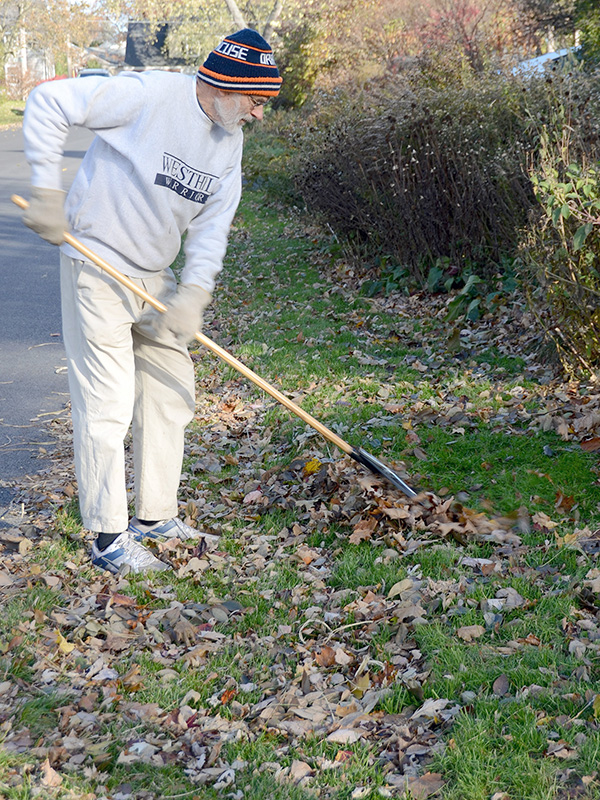
It’s best to leave the leaves where they fall anyway (except for those on lawns), and even then leaves can be shredded by a mulching mower and left on the lawn as free fertilizer as the leaves decompose.
For areas of the lawn with more leaves, we use an actual old-fashioned leaf rake and put them in our planting beds, or if there are too many, we put them in our leaf barrels to create leaf compost.
Equally crazy is using a leaf blower to blow leaves off the lawn or even to clean the sidewalk or driveway — something we often see being done in our neighborhood.
Even worse is to hose it down with water — potable water! (And most people aren’t aware that supplying our municipal water uses quite a bit of energy.)
How did we come to the point in this country where we can’t use a push broom? So simple a child can do it!
We think of it as free exercise.
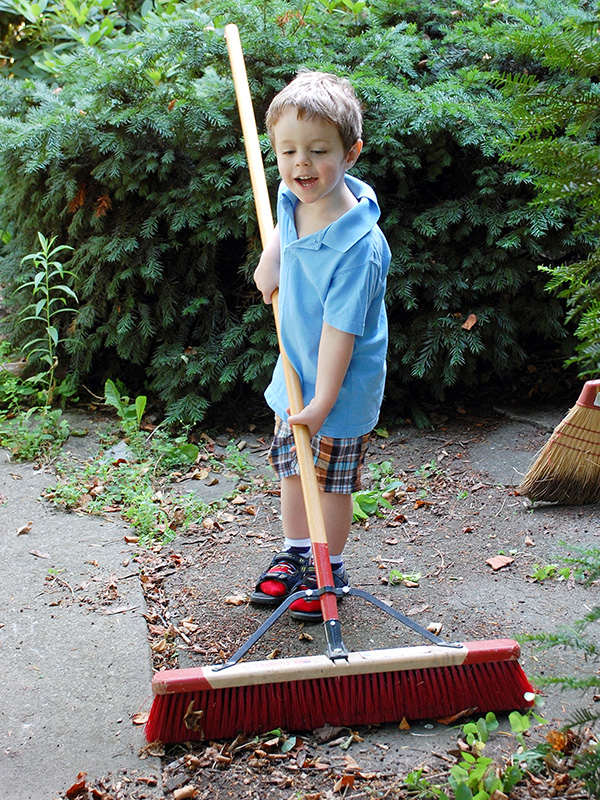
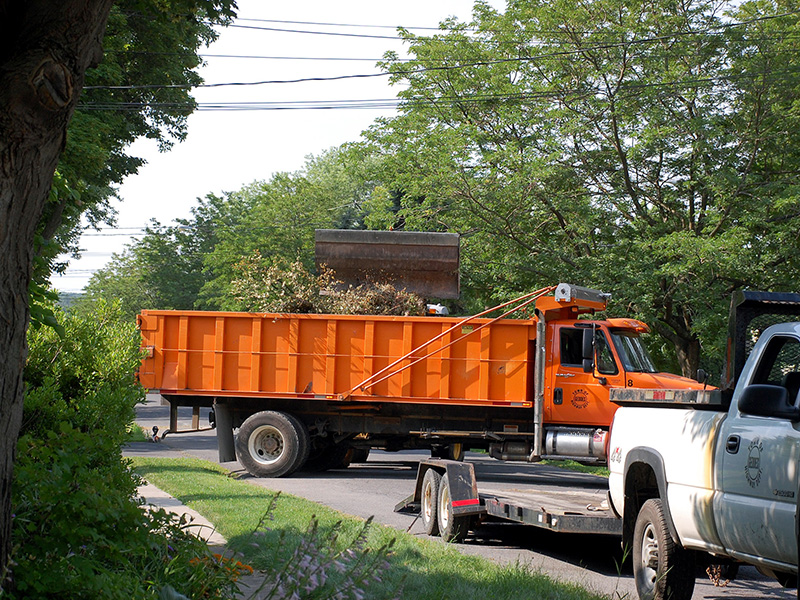
Think of all the fossil fuel used by these trucks collecting yard “waste” each week when much of it could simply be left on planting beds. If there are too many leaves for planting beds, there is too much lawn!!
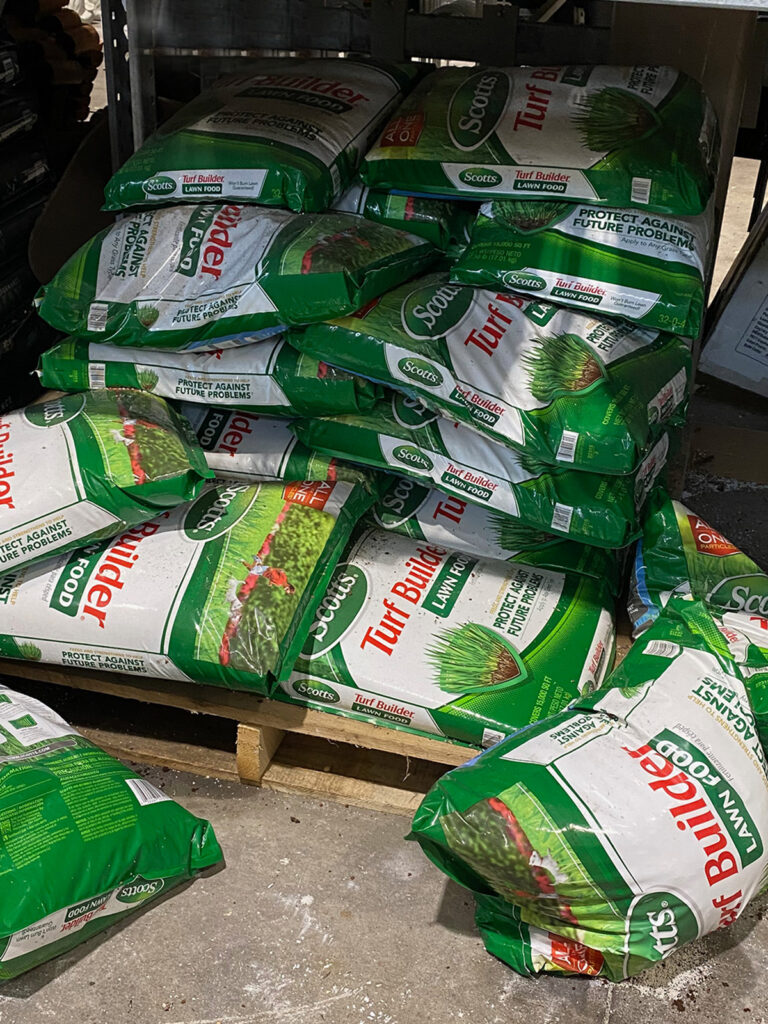
Less obvious contributions to climate change are chemical fertilizers, pesticides, and herbicides. Considering their whole life-cycle, they’re carbon-intensive.
We don’t use any of these products not just because of climate, but because they don’t create and preserve healthy soil.
Not leaving soil naked
Many organizations recommend growing cover crops on any bare ground since they provide fertilizer (when dug in) and also store carbon. We don’t have much bare soil in our habitat garden. We grow perennials, grasses, shrubs, and trees in every available space, and we leave any fallen leaves (not just from trees but from all plants) where they fall.
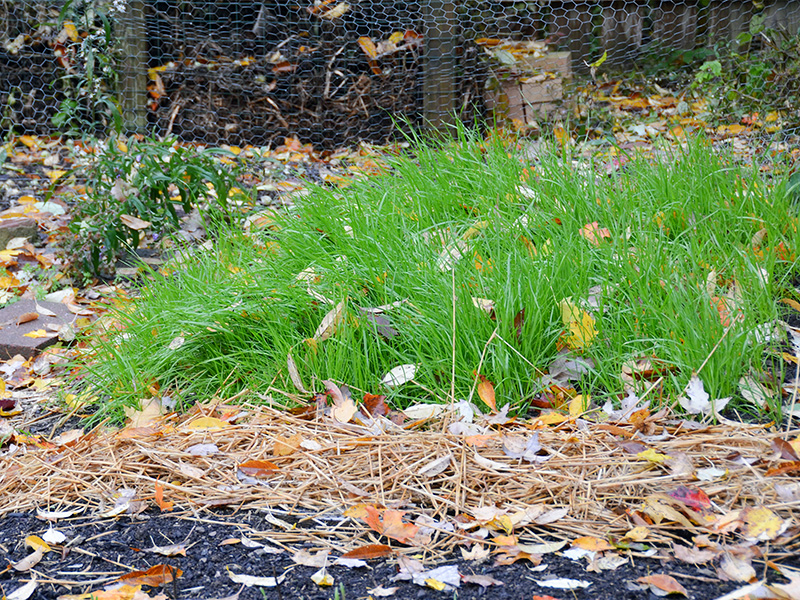
We do grow cover crops in Our Edible Garden, though, which we dig into the soil in the spring.
And by growing much of our own fruits and vegetables (about 600 lb/yr!), we’re minimizing food transportation costs (besides being tastier, more nutritious, and pesticide-free).
Planting trees and shrubs
Planting trees and shrubs store carbon and reduce the need for air conditioning. We’ve planted quite a few trees and shrubs, and many of our deciduous trees and shrubs are on the south and west sides of the house which helps cool our house.
It’s important, too, that trees on the south side are deciduous trees that drop their leaves in fall. The sun coming through the windows helps warm up the house in the winter, though here in cold CNY, it certainly can’t be only source of heat.
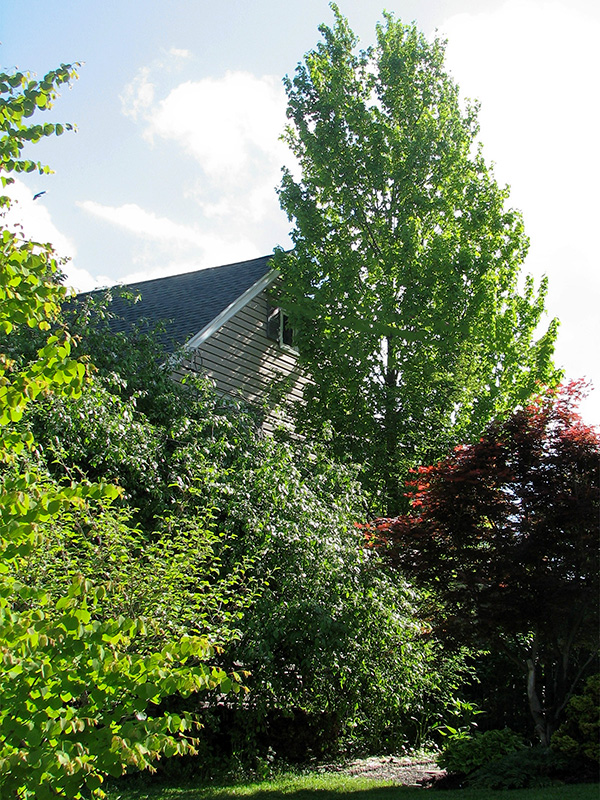
Originally, a large Norway maple had overhung the porch on the south side of our house, cooling it nicely. When we lost it to the 1998 Labor Day Storm (not a tornado, but a derecho), we had a vivid demonstration of the power of trees to cool a house!
Until our new maple grew tall enough, the porch was pretty much unusable. But I’m glad we were rid of the Norway maple, a non-native invasive plant.
Our A/C unit is also on this side of the house, so the tree cools this equipment, too.
NOTE: This red maple (Acer rubrum ‘Armstrong’) (the tall tree sticking up over the roof line) is a cultivar that grows in a column shape, the only shape that would fit in the narrow space between our house and the neighbor’s house. Though we now favor the plain species, having to meet a specific requirement — in this case, needing a tall shade tree growing in a small space — is one of the few times a cultivar may indeed be needed.
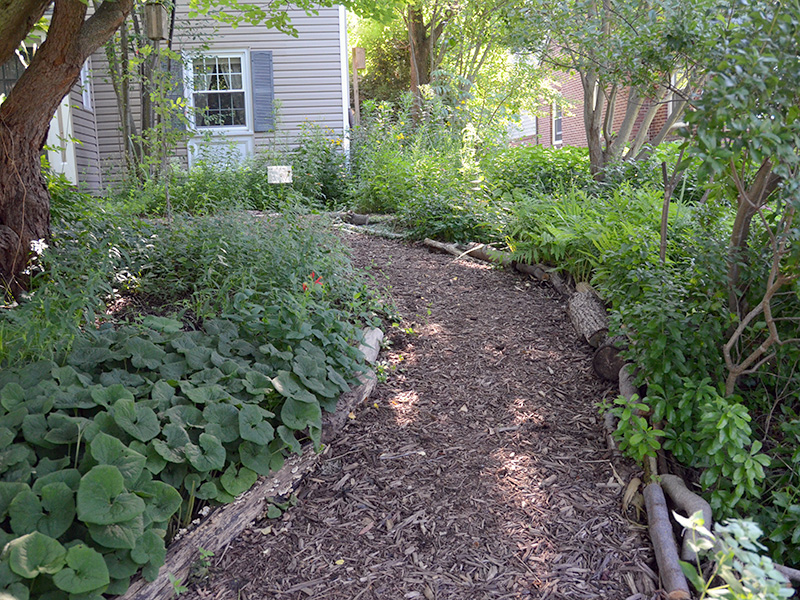
One hot July day, I measured the temperature at midday in the sunny part of the yard and in a shady part of the yard. It was 96° in the sun, but was a much cooler 85° in the shade of the trees and shrubs just a few feet away.
And besides the temperature difference, there was just a cooler feel when we were in the shade, partly due to the psychology of being in a shady, forest-y area and probably also because of the evapo-transpiration from the trees.
And another hotter day I compared the temps between the shady path and the dirt next to the rain drain near the road — about 30 degrees difference!
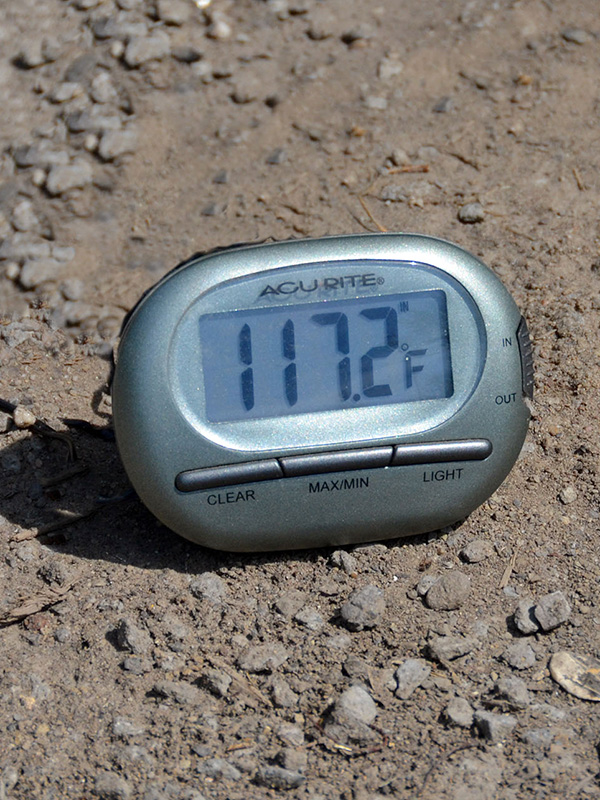
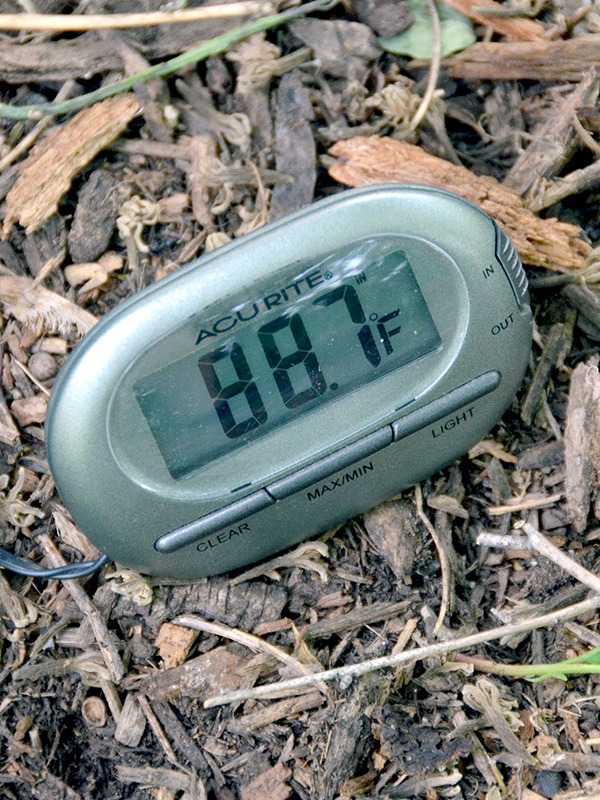
And, of course, we’re preserving existing canopy trees, most of which in our area are mature native trees with a long life span ahead of them. Sadly, many of these old trees are being cut down in our neighborhood, releasing stored carbon and sacrificing their future contribution to storing carbon and cooling the area.
An aside …
Planting and caring for our own trees is important. It’s much different from the massive tree-planting projects used for carbon offsets designed to make us feel less guilty about flying and spending money on lots of stuff. Many, if not most, of these projects fail since after planting there often is little care given to the seedlings.
Often, they’re forest industry plantings in disguise, often non-native trees planted in a monoculture — very different from a genuine forest. And when later harvested for wood they release sequestered carbon.
- Learn more:
Expanding recycling to the garden
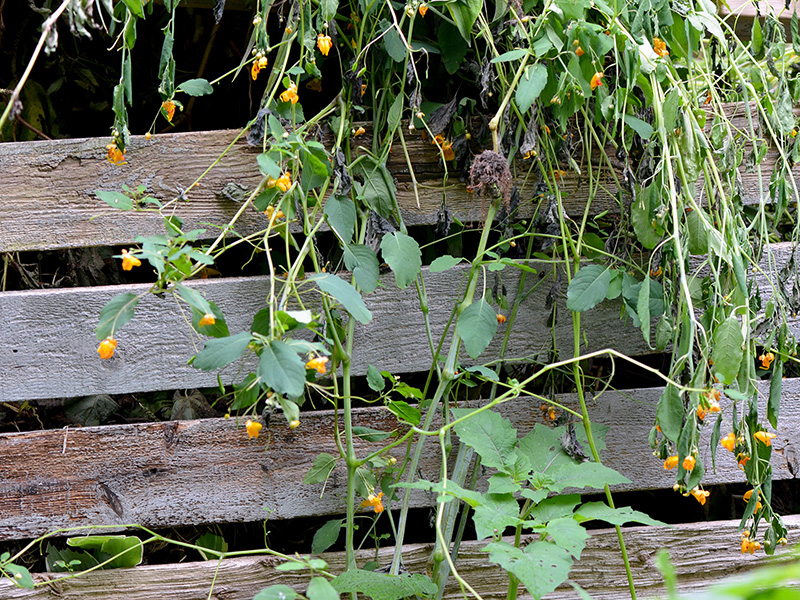
We compost almost all our yard waste in compost bins and sometimes just in a pile in an out-of-the-way place.
We compost all our kitchen food scraps, too, in worm bins in the cellar. This vermicompost is used in Our Edible Garden.
Bottom line: Not much that is eaten or grown on our property needs to be carted off to the landfill or incinerator!
Thinking long and hard about lawn
We did that thinking long ago! We’ve been really happy with our decisions to:
- dramatically reduce our lawn area,
- use some alternatives to lawn in some areas, and
- take care of our small remaining lawn organically.
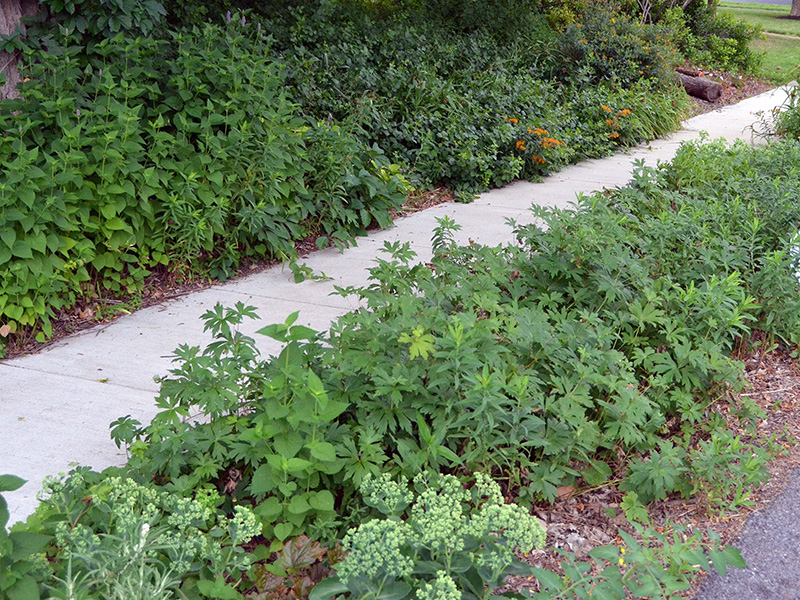
One change was to convert lawn in the “hellstrip” to planting beds.
Of course, not having a conventional lawn also enables us to conserve water. After touring the new sewage treatment plant a few years ago, we were surprised to learn that considerable energy is used to treat and move water into reservoirs. And so we conserve water in other ways, too.
Growing some of our own food
Two things can make a difference: growing our own food and eating an earth-friendly plant-based diet. The happy coincidence is that these are the healthiest options, too!
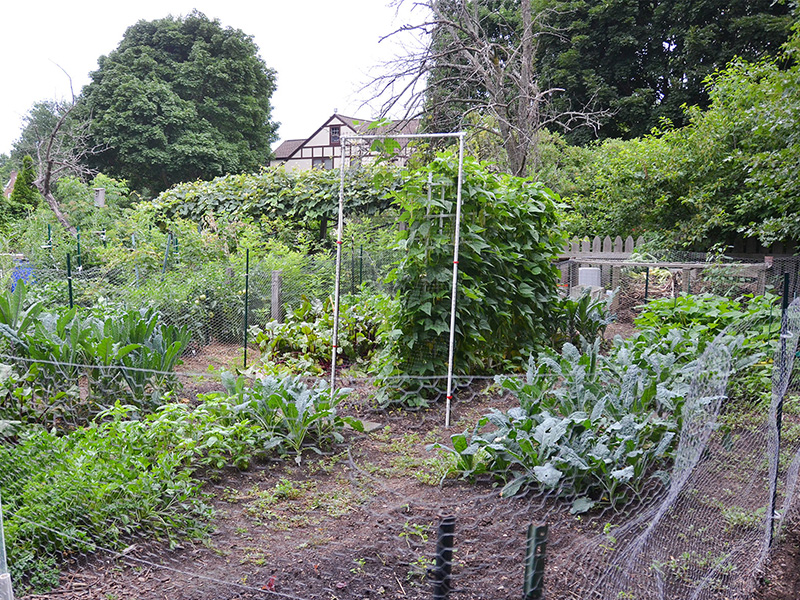
We describe our edible garden on the OurEdibleGarden.org website.
John is in charge of this part of our yard, and all our produce is organic.
It’s been determined that every pound of food grown in home or community gardens reduces greenhouse gas emission by two pounds [reported in Climate-Wise Landscaping by Sue Reed]. This is certainly a good use of part of our yard, amounting to about half of our back yard.
The second part is important, too. We eat a strongly plant-based diet — with the addition of dairy and twice-weekly meals of canned salmon or sardines — that is very low in processed foods. We cook virtually everything from scratch, using non-Teflon (PFAS) pots and pans AND we’re careful not to waste food. We choose organic ingredients — even those that may not directly benefit our own health but do affect the planet. This diet is not only earth- and climate-friendly, but healthy and delicious, too.
Some other steps we’ve taken
UCS didn’t mention some of the other things we’re doing. They aren’t specifically gardening, but they have to do with how we use our yard and organize our landscape.
Our solar dryer
I never have enough space to grow everything I’d like to grow, but even so, I make room for my clothesline so we don’t have to use the electric dryer, the second-biggest electricity-using home appliance after the refrigerator.
A bonus is that it’s a good reason to be outside in the cool, fresh morning air, serenaded by birds. And it really doesn’t take very long when you get the “hang” of it.
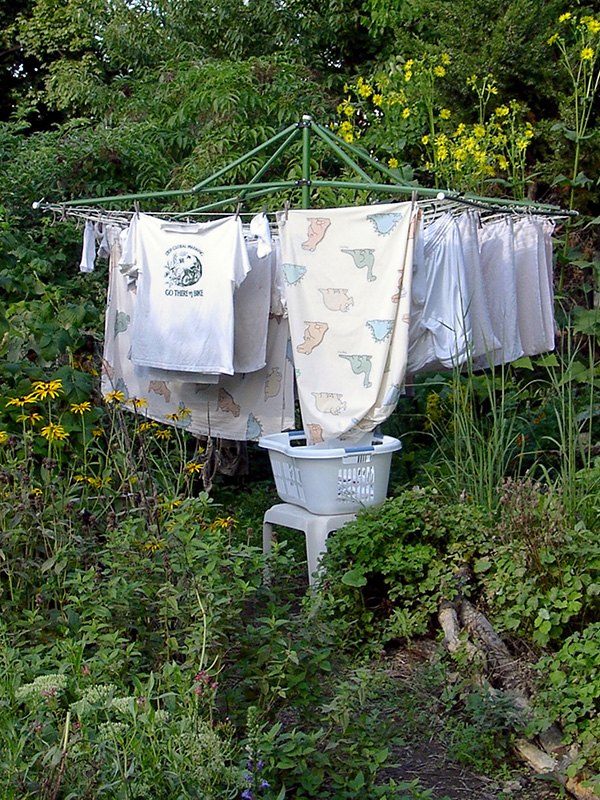
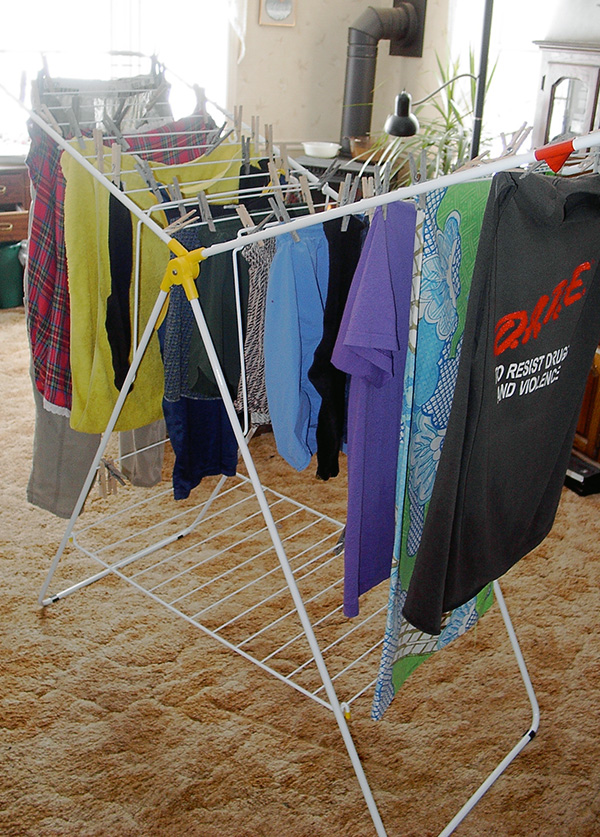
What about winter in CNY?
We hang our clothes indoors in the winter, too, and has the bonus of providing some extra humidity, too.
We haven’t used the electric dryer more than once or twice in the last few decades.
IMPORTANT: We always use the cold water setting to wash. This saves a LOT of energy since 90% of the energy used by the washing machine goes to heat the water! Laundry detergent formulated for cold water wash gets clothes just as clean in cold water.
Lighting
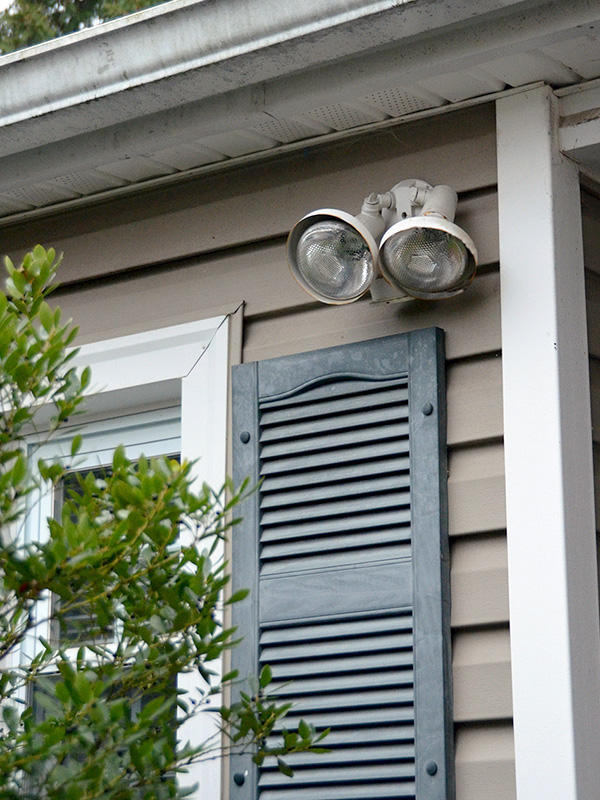
We use motion-detector security lights outside so we’re using electricity for lights only when some movement activates them, rather than having them on all night. (And all that extra nighttime light would otherwise interfere with fireflies and other nocturnal creatures.)
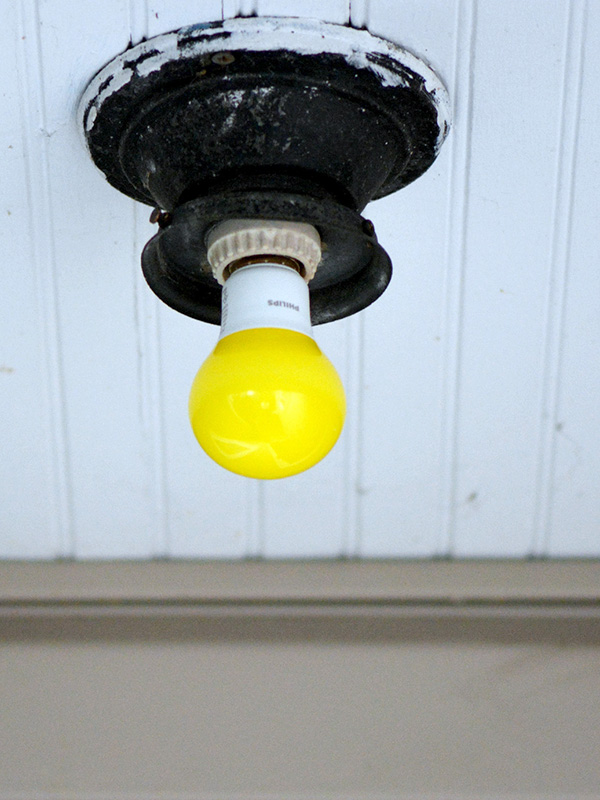
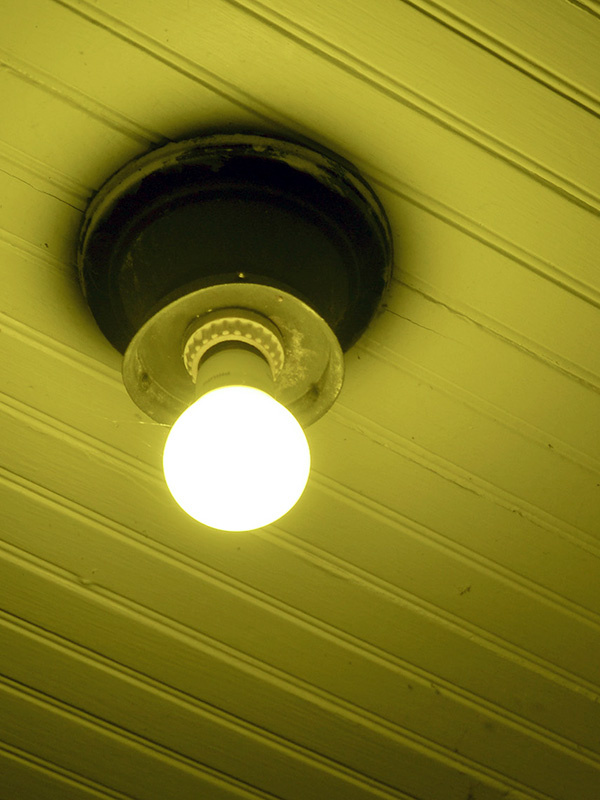
We replaced our overhead porch light with a yellow bulb for those times we need to have a porch light on, for example when we’re waiting for someone to arrive. In that case, it at least doesn’t attract moths or other insects to their demise.
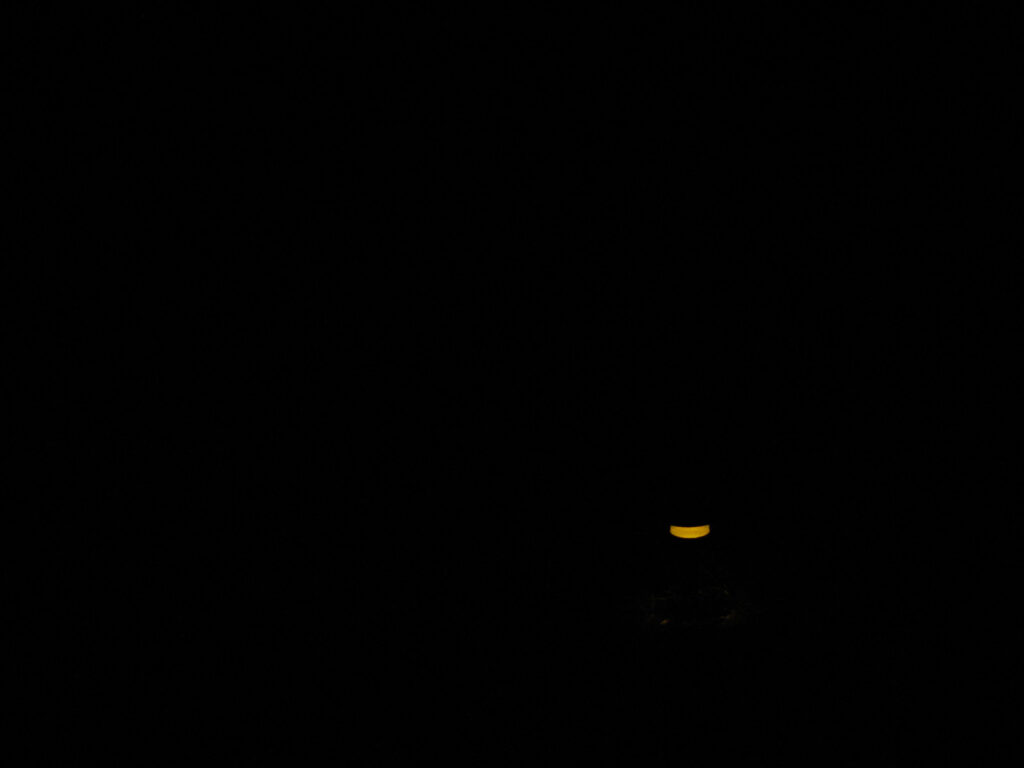
And we definitely do NOT use lighting to highlight trees, outdoor walls, or anything else. This would be an irresponsible use of energy, besides interfering with nocturnal wildlife.
For a while, we used a single solar light, but when that stopped working we didn’t replace it. Our yard is dark at night, as night is supposed to be.
Community science
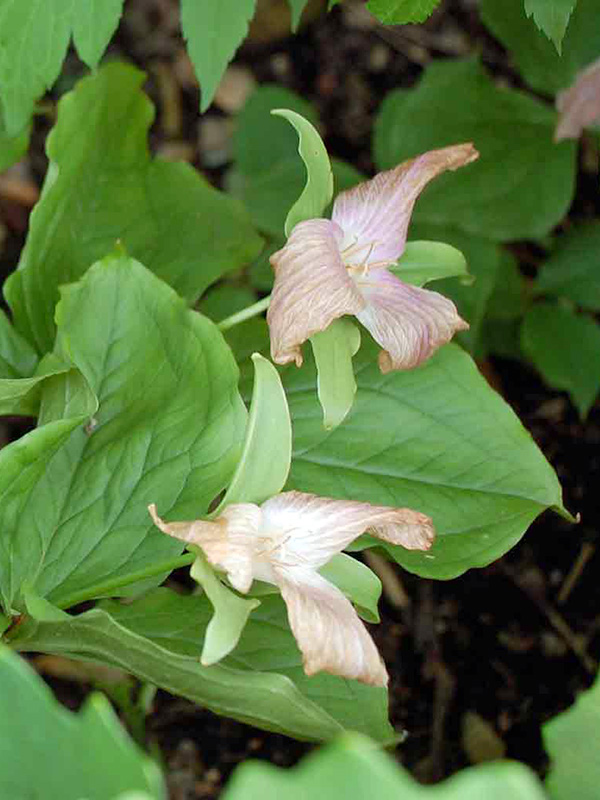
We’re helping scientists learn more about global warming by participating in community science phenology projects. Phenology is the timing of plant and animal life cycle events. Collecting this data help scientists determine how climate is changing.
At various times, I have participated in Project BudBurst and also the National Phenology Network. (I’ve also contributed some photos to their ID sheets to illustrate various phenophases of plants, such as this photo showing a phenophase of a trillium.)
Collecting current climate-related data is essential. We need as much data on as many pieces of life on earth as possible. Once the opportunity to collect this information is missed, it can never be collected again. Particularly valuable is comparing today’s data with data from the past. That’s why I participated in the (now apparently defunct) North American Bird Phenology Program. Oddly, even though it was just transcribing bird observation cards into a digital format, I found it interesting. And I felt good about participating in this very concrete way to help scientists learn about climate change and bird conservation.
Resources
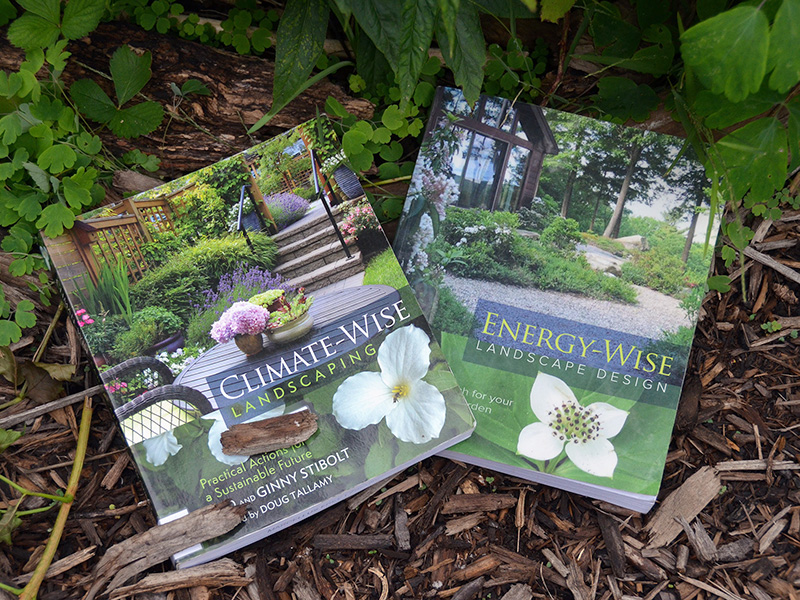
- HIGHLY RECOMMENDED books by Susan Reed, a landscape architect. Practical advice for our yards and landscaping:
- Climate-Wise Landscaping: Practical Actions for a Sustainable Future (2018) by Sue Reed and Ginny Stibolt has a wealth of ideas for landscaping in a climate-friendly way.
- Sue Reed’s previous book, Energy-Wise Landscape Design: A New Approach for your Home and Garden (2010) is also very good.
- Wild Ones Journal:
- Dealing with climate change in our landscapes by Kim Eierman of EcoBeneficial
- Climate and Landscaping by Janet Allen – An article I wrote for the Wild Ones Journal
- Biodiversity for a Livable Climate:
- Nature is climate
- DOCUMENTARY: Regenerating Life
- VIDEO: How plants could save us (5 min.)
- VIDEO: Hydrate – the role of water (5 min.)
- United Nations:
- Earth.org:
- Are you suffering from Shifting Baseline Syndrome?
“Simply put, Shifting Baseline Syndrome is ‘a gradual change in the accepted norms for the condition of the natural environment due to a lack of experience, memory and/or knowledge of its past condition’. In this sense, what we consider to be a healthy environment now, past generations would consider to be degraded, and what we judge to be degraded now, the next generation will consider to be healthy or ‘normal’.”
- Are you suffering from Shifting Baseline Syndrome?
- Axios:
- The Energy Mix:
- Ecological Gardening:
- Cornell Climate Smart Solutions Program:
- Gardening in a Warmer World – a course
- Cornell Human Ecology:
- National Wildlife Fed’n:
- Why you should leave the leaves – leaves in landfills cause more methane!
- The Atlantic:
- NY Times:
- Our response to climate change is missing something big, scientists say
- Beautiful and terrifying arrival of an early spring
- Unearthing the secret superpowers of fungus – a formidable ally!
- Tree planting is booming. Here’s how that could help, or harm the planet
- What you may not know about poison ivy
- You may miss these parasites when they’re gone
- We thought we were saving the planet but we were planting a time bomb
- Ecological Landscape Alliance:
- Climate-wise landscaping: Practical solutions for a sustainable future
- Climate change reshaping urban tree populations
- Taking it to the extremes – managing land in a time of climate change
- Starving for darkness – effects on animals and plants
- Center for Science in the Public Interest:
- Mongabay:
- Leave Leaves Alone!:
- NYS organization founded by Master Gardeners and others – includes info on a proposed gas leaf blower ban for NYS
- PBS The Green Planet:
- VIDEO: Effect of climate change on different biomes and plants Excellent!
- National Wildlife Federation:
- Xerces Society:
- Grist:
- UN Report: Climate changing too fast for plants and animals to adapt
- Want to sequester carbon? Save wild animals
- How climate change is muting nature’s symphony
- Does planting trees actually help the climate? Here’s what we know
- Climate change is creating disease hotspots
- How pesticides intensify global warming
- Tufts Now:
- Phys.org – Univ. of Calif.:
- U.S. Dept. of Energy:
- Green America:
- SUGi:
- EcoBeneficial:
- One Earth:
- David Suzuki Foundation:
- Columbia Univ. – Columbia Climate School:
- Revisionist History podcast with Malcolm Gladwell:
- Laundry done right (But why not wait to run the dishwasher until it’s full??)
- Audubon Magazine:
- Washington Post:
- Native Plant Trust:
- World Meteorological Organization:
- Int’l Dark-Sky Assoc.:
- Yale Environment360:
- As climate warms, a rearrangement of world’s plant life looms
- As Africa loses forest, its small farmers are bringing back trees
- Phantom forests: Why ambitious tree-planting projects are failing
- For a scientist and mother, climate change is generational robbery
- Amid climate pressures, a call for a plan to move endangered species
- Soil as carbon storehouse – New weapon in climate fight?
- Do forests grow better with our help or without?
- Are huge tree planting projects more hype than solution?
- Bringing back the beasts: Global rewilding plans take shape
- Climate opinion maps
- Rodale Institute:
- Mother Jones:
- NOAA:
- Highstead:
- Grist:
- The Nature Conservancy’s Cool Green Science:
- The Guardian:
- ‘Playing the hand of God’: scientists’ experiment aims to help trees survive climate change – The possibilities and possible dangers of helping trees move
- The Atlantic:
- Project Drawdown:
- Climate solutions video course – six short videos
- Sustainable World:
- VIDEO: The Soil Solution to Climate Change – 30-min video
- Grow Native Massachusetts:
- Pollinator Partnership:
- Penn State Extension:
Shading and evapotranspiration (the process by which a plant actively moves and releases water vapor) from trees can reduce surrounding air temperatures as much as 9°F. Because cool air settles near the ground, air temperatures directly under trees can be as much as 25°F cooler than air temperatures above nearby blacktop.
~ US Dept. of Energy: More about landscaping shading
Green roofs: If you have the proper roof (and it does NOT have to be flat), you could consider a green roof. They have many advantages.
Reflections
We were told that there would come a time when the world would be covered with smoke, and that it would take our elders and our children. It was difficult to comprehend at the time, but now all we have to do is but to walk outside to experience that statement.
We were told that there would come a time when we could not find clean water to wash ourselves, to cook our foods, to make our medicines, and to drink. And there would be disease and great suffering. Today we can see this and we peer into the future with great apprehension.
We were told there would come a time when, tending our gardens, we would pull up our plants and the vines would be empty. Our precious seed would begin to disappear …
Even though you and I are in different boats, you in your boat and we in our canoe, we share the same River of Life — what befalls me, befalls you. And downstream, downstream in this River of Life, our children will pay for our selfishness, for our greed, and for our lack of vision.
~ Chief Oren Lyons, Faithkeeper, Onondaga Nation, Address to the UN, Dec. 1992
At the individual level, we face two significant psychological barriers.
First, we find it difficult to fully grasp the enormity of living at a time when we are destroying the natural systems on which all life (and the global economy) depends. Somehow that reality does not seem real.
Second, we are not able to respond to threats that are remote in time and space.
For example, I might believe that future generations are threatened as certainly as a child on a railroad track in front of a speeding train. For that child, I might risk my life. For future generations, I find it difficult to even forgo comforts.
~ Dick Roy, founder of Northwest Earth Institute (now EcoChallenge.org), referring to climate change, but the concept applies to changing our landscaping practices, too.
If some of these answers seem radical or far-fetched today, then I say wait until tomorrow. Soon it will be abundantly clear that it is business as usual that is utopian, whereas creating something very new and different is a practical necessity.
~ James Gustave Speth, Dean, Yale School of Forestry and Environmental Studies
[Speth is referring specifically to the limits of growth, but the concept is also quite applicable to changing our treatment of the earth in our yards]
I used to think the top environmental problems were biodiversity loss, ecosystems collapse, and climate change. But I was wrong. The top environmental problems are selfishness, greed, and apathy… and to deal with those, we need a spiritual and cultural transformation.
~ James Gustave Speth, Dean, Yale School of Forestry and Environmental Studies
Based on the most recent research, we really have no idea how wildlife will react to climate change. At the forefront of the battle every simple action makes a difference. Every yard, every park, and every open space would do well to be planted with native species that support wildlife by establishing forage, shelter, migration, overwintering, and escape habitats.
~ Bill Lattrell, Restoration ecologist at The Conway School
We have to wake up that the threats we are facing are getting bigger and bigger. We have to restore biodiversity, the natural protection against disease and droughts.
~ Diana Ürge-Vorsatz, scientist and mother; For a scientist and mother, climate change is generational robbery – Yale e360
But the gasoline-powered leaf blower exists in a category of environmental hell all its own, spewing pollutants — carbon monoxide, smog-forming nitrous oxides, carcinogenic hydrocarbons — into the atmosphere at a literally breathtaking rate.
~ Margaret Renkl, The first thing we do, let’s kill all the leaf blowers – New York Times
The rhythms of life shaped by millions of years of evolution are being challenged and altered by our rapidly changing climate. The connections long established between plants and their pollinators are of particular concern since these interdependencies shape and sustain nearly all terrestrial ecosystems. Our future will be defined by how well we understand and maintain these connections.
~ Orley “Chip” Taylor, Former Director of Monarch Watch
In years to come as our children and grandchildren grow up in a dangerously deteriorating world, they will ask us the same terrible questions asked after the abolition of slavery, after the fall of the Third Reich, after the civil rights movement finally put an end to the shame of legal segregation — the same awful and incredulous questions asked of every human being complacent in the face of evil: How could you not have known? Knowing what you knew, how could you have failed to act?
~ Rev. Fred Small
How could I look my grandchildren in the eye and say I knew about this and did nothing?
~ Sir David Attenborough, naturalist and BBC nature program producer/host
What we forget today is that while labor-saving devices are not all bad, neither is labor …
~ Doris Longacre, Living More with Less
What we will do in the next two, three years will determine our future. This is the defining challenge.
~ Rajendra Pachauri, chair of the International Panel on Climate Change
It may seem impossible to imagine that a technologically advanced society could choose, in essence, to destroy itself, but that is what we are now in the process of doing.
~ Elizabeth Kolbert, Field Notes from a Catastrophe
In the course of history, there comes a time when humanity is called to shift to a new level of consciousness, to reach a higher moral ground. A time when we have to shed our fear and give hope to each other.
~ Wangari Maathai, Nobel Lecture, delivered in Oslo, 10 December 2004
Video reflection
- Climate Reality Project:
